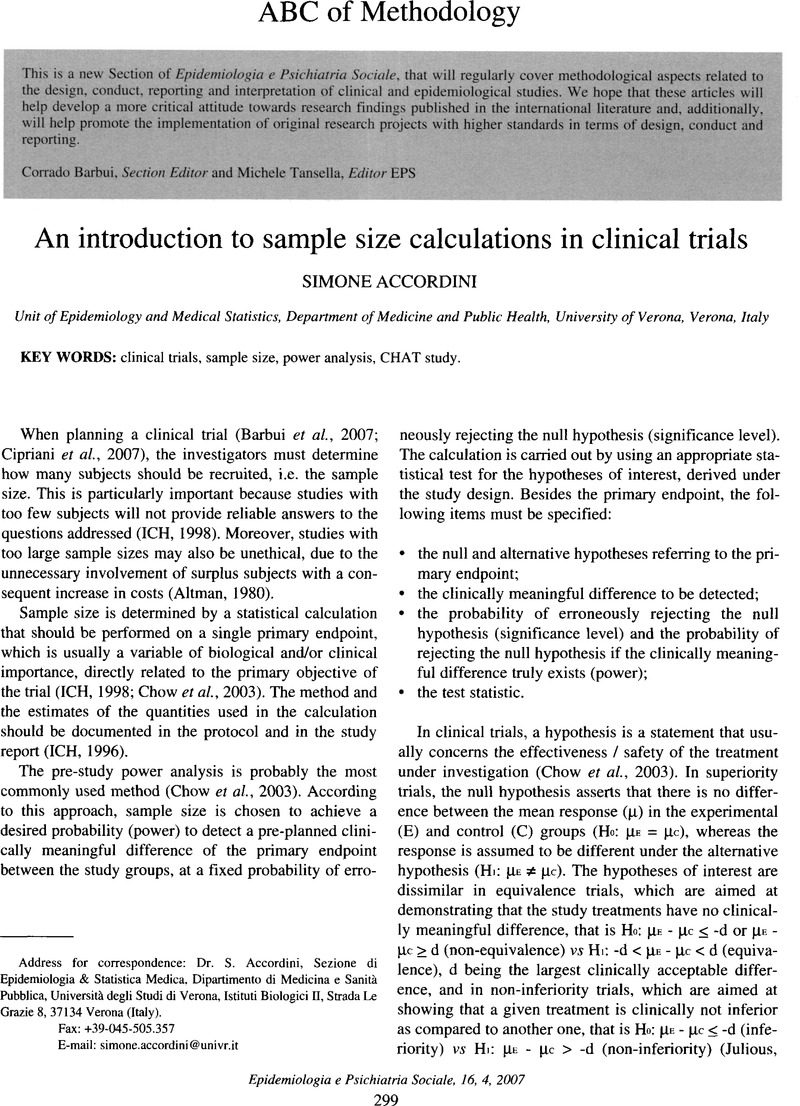Crossref Citations
This article has been cited by the following publications. This list is generated based on data provided by Crossref.
Cipriani, Andrea
Girlanda, Francesca
and
Barbui, Corrado
2009.
Superiority, equivalence or non-inferiority?.
Epidemiology and Psychiatric Sciences,
Vol. 18,
Issue. 4,
p.
311.
Esposito, Eleonora
Cipriani, Andrea
and
Barbui, Corrado
2009.
Outcome reporting bias in clinical trials.
Epidemiologia e Psichiatria Sociale,
Vol. 18,
Issue. 1,
p.
17.
Nosè, Michela
Accordini, Simone
Artioli, Paola
Barale, Francesco
Barbui, Corrado
Beneduce, Rossella
Berardi, Domenico
Bertolazzi, Gerardo
Biancosino, Bruno
Bisogno, Alfredo
Bivi, Raffaella
Bogetto, Filippo
Boso, Marianna
Bozzani, Alberto
Bucolo, Piera
Casale, Marcello
Cascone, Liliana
Ciammella, Luisa
Cicolini, Alessia
Cipresso, Gabriele
Cipriani, Andrea
Colombo, Paola
Dal Santo, Barbara
De Francesco, Michele
Di Lorenzo, Giorgio
Di Munzio, Walter
Ducci, Giuseppe
Erlicher, Arcadio
Esposito, Eleonora
Ferrannini, Luigi
Ferrato, Farida
Ferro, Antonio
Fragomeno, Nicoletta
Parise, Vincenzo Fricchione
Frova, Maria
Gardellin, Francesco
Garzotto, Nicola
Giambartolomei, Andrea
Giupponi, Giancarlo
Grassi, Luigi
Grazian, Natalia
Grecu, Lorella
Guerrini, Gualtiero
Laddomada, Francesco
Lazzarin, Ermanna
Lintas, Camilla
Malchiodi, Francesca
Malvini, Lara
Marchiaro, Livio
Marsilio, Alessandra
Mauri, Massimo Carlo
Mautone, Antonio
Menchetti, Marco
Migliorini, Giuseppe
Mollica, Marco
Moretti, Daniele
Mulè, Serena
Nicholau, Stylianos
Nosè, Flavio
Occhionero, Guglielmo
Pacilli, Anna Maria
Pecchioli, Stefania
Percudani, Mauro
Piantato, Ennio
Piazza, Carlo
Pontarollo, Francesco
Pycha, Roger
Quartesan, Roberto
Rillosi, Luciana
Risso, Francesco
Rizzo, Raffella
Rocca, Paola
Roma, Stefania
Rossattini, Matteo
Rossi, Giuseppe
Rossi, Giovanni
Sala, Alessandra
Santilli, Claudio
Saraò, Giuseppe
Sarnicola, Antonio
Sartore, Francesca
Scarone, Silvio
Sciarma, Tiziana
Siracusano, Alberto
Strizzolo, Stefania
Tansella, Michele
Targa, Gino
Tasser, Annamarie
Tomasi, Rodolfo
Travaglini, Rossana
Veronese, Antonio
and
Ziero, Simona
2009.
Rationale and design of an independent randomised controlled trial evaluating the effectiveness of aripiprazole or haloperidol in combination with clozapine for treatment-resistant schizophrenia.
Trials,
Vol. 10,
Issue. 1,
Cipriani, Andrea
and
Geddes, John R.
2010.
What is a run-in phase?.
Epidemiologia e Psichiatria Sociale,
Vol. 19,
Issue. 1,
p.
21.
Barbui, Corrado
Accordini, Simone
Nosè, Michela
Stroup, Scott
Purgato, Marianna
Girlanda, Francesca
Esposito, Eleonora
Veronese, Antonio
Tansella, Michele
and
Cipriani, Andrea
2011.
Aripiprazole Versus Haloperidol in Combination With Clozapine for Treatment-Resistant Schizophrenia in Routine Clinical Care.
Journal of Clinical Psychopharmacology,
Vol. 31,
Issue. 3,
p.
266.
Cipriani, Andrea
Accordini, Simone
Nosè, Michela
Purgato, Marianna
Girlanda, Francesca
Tansella, Michele
and
Barbui, Corrado
2013.
Aripiprazole Versus Haloperidol in Combination With Clozapine for Treatment-Resistant Schizophrenia.
Journal of Clinical Psychopharmacology,
Vol. 33,
Issue. 4,
p.
533.



